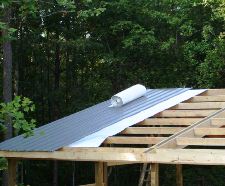A vapor retarder is a material used to prevent water vapor from diffusing into the wall ceiling or floor during the cold winter.
Vapor barrier metal roof residential.
A gypsum fiber board has a perm rating of approximately 24 to 30 perms depending on thickness and if this board is fastened to a steel deck and the joints and transitions are taped it could be an effective air barrier that.
Several considerations must be addressed in the roofing system design including ensuring that the four barriers needed in any building enclosure i e water barrier thermal insulation barrier vapor retarder and air barrier are provided and are in the correct location for a given climate.
The problem with using.
We ll add a vapor barrier so the moist air does not flow up through the insulation and condense on the roof.
A roof vapor barrier needs to have different properties to a barrier in a wall or one used to prevent radon permeating through a floor.
After the insulation is in place you will want to add a vapor retarder sometimes called a vapor barrier if you need one.
Water vapor can pass through building materials in several ways including direct transmission and by heat transfer but studies suggest that fully 98 percent of the moisture transfer through walls occurs through air gaps including cracks around electrical fixtures and outlets and gaps along baseboards.
Not every wall does.
In this example although roofs and walls both need similar water vapor barrier properties the roof barrier often needs to be either inflexible or air permeable to prevent being blown away in an updraft.
Traditionally we ve insulated the roof panel to try and keep the temperature on the panel from reaching the dew point.
Another option for the roofing system is to recognize a hardboard or sheathing layer can be a vapor open air barrier.

